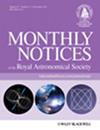Anisotropic energy injection from magnetar central engines in short GRBs
IF 4.7
3区 物理与天体物理
Q1 ASTRONOMY & ASTROPHYSICS
引用次数: 0
Abstract
A long-lived magnetar, potentially originating from a binary neutron star system, has been proposed to explain the extended emission observed in certain short-duration gamma-ray bursts (sGRBs), and is posited as a potential central engine to power the engine-fed kilonovae. Previously, the process by which energy is injected into the surrounding ejecta/jet was widely believed to be nearly isotropic. In this study, we employ special relativity magnetohydrodynamic (SRMHD) simulations to investigate the wind injection process from a magnetar central engine. We explore the dynamics and energy distribution within the system and found that the parameter α = uA/uMWN can be used to indicate the collimation of the magnetar wind energy injection, where uA is the local Alfven four-speed and uMWN is the four-speed of the magnetar wind nebular (MWN) formed from wind-ejecta collision. A significant portion of the injected energy from the magnetar spin-down wind will be channeled to the jet axis due to collimation within the MWN. Achieving isotropic energy injection requires a significantly small α that necessitates either an ultra-relativistic expanding MWN or an extremely low magnetization MWN, both of which are challenging to attain in sGRBs. Consequently, a considerably reduced energy budget (i.e. energy per solid angle reduced by a factor of up to 10 with respect to the value under isotropic assumption) is anticipated to be injected into the ejecta for engine-fed kilonovae. Engine-fed kilonovae would appear fainter than originally anticipated.短GRB中磁星中央引擎的各向异性能量注入
有人提议用可能源自双中子星系统的长寿命磁星来解释在某些短时伽马射线暴(sGRBs)中观测到的扩展发射,并将其假定为一个潜在的中央引擎,为千新星提供动力。以前,人们普遍认为能量注入周围喷出物/喷流的过程几乎是各向同性的。在这项研究中,我们采用狭义相对论磁流体力学(SRMHD)模拟来研究磁星中央引擎的风注入过程。我们探索了系统内的动力学和能量分布,发现参数 α = uA/uMWN 可用来表示磁星风能量注入的准直度,其中 uA 是局部阿尔芬四速,uMWN 是风-抛射体碰撞形成的磁星风星云(MWN)的四速。由于 MWN 内的准直作用,磁星自旋下降风的大部分注入能量将被导入喷流轴。要实现各向同性的能量注入,α必须非常小,这就需要一个超相对论膨胀的MWN或者一个磁化率极低的MWN,而这两者在sGRB中都很难实现。因此,预计注入发动机供能千新星喷出物的能量预算会大大减少(即与各向同性假设下的值相比,每个固角的能量最多减少 10 倍)。发动机驱动的千新星会比原先预计的更暗。
本文章由计算机程序翻译,如有差异,请以英文原文为准。
求助全文
约1分钟内获得全文
求助全文
来源期刊

Monthly Notices of the Royal Astronomical Society
ASTRONOMY & ASTROPHYSICS-
CiteScore
9.10
自引率
37.50%
发文量
3198
审稿时长
3 months
期刊介绍:
Monthly Notices of the Royal Astronomical Society is one of the world''s leading primary research journals in astronomy and astrophysics, as well as one of the longest established. It publishes the results of original research in positional and dynamical astronomy, astrophysics, radio astronomy, cosmology, space research and the design of astronomical instruments.
 求助内容:
求助内容: 应助结果提醒方式:
应助结果提醒方式:


